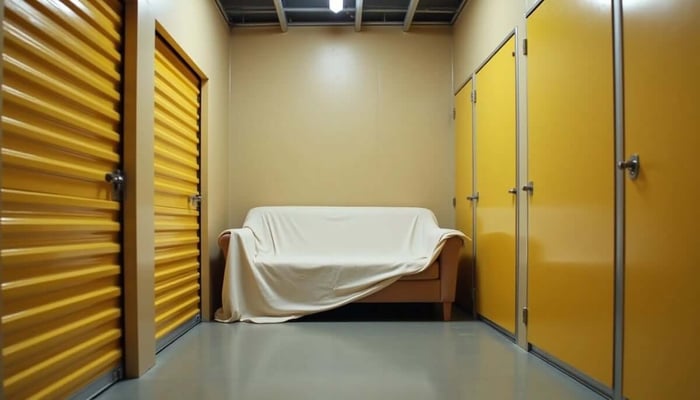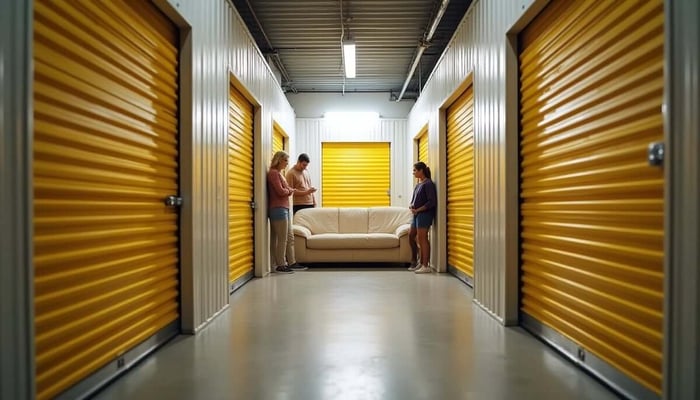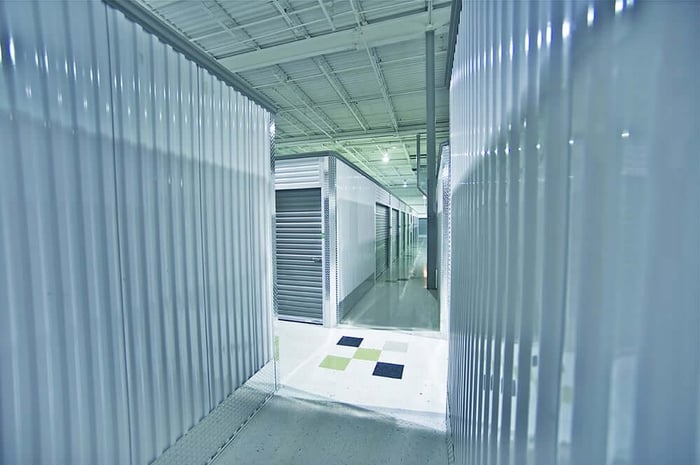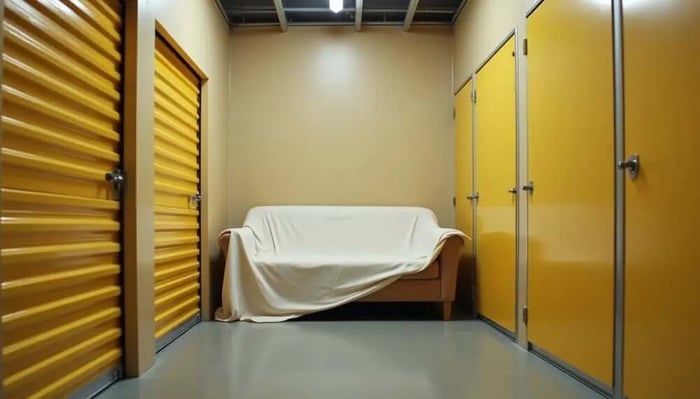Table of Contents
- Why Choose Climate-Controlled Storage for Furniture
- Do You Need a Temperature-Regulated Unit for Your Furniture?
- What Materials You’ll Need When Prepping for Storage
- How To Store Furniture in a Climate-Controlled Unit
- Special Considerations for Delicate or High-Value Items
- Special Considerations for Extreme Climates
- Frequently Asked Questions About Furniture Storage Tips
- Proper Prep Equals Peace of Mind
- FAQs
You’ve taken the time to find the perfect self-storage unit for your things, but your diligence shouldn’t stop there! Even in a climate-controlled space, your furniture needs the right prep and packing to stay in great shape. From wood tables and leather sofas to antiques, electronics, and collectibles, each item requires a little extra care before being tucked away. In this guide, we’ll show you how to pack furniture for climate-controlled storage so your favorite pieces stay clean, protected, and ready to enjoy whenever you need them again.
Why Choose Climate-Controlled Storage for Furniture
When it comes to storing furniture, especially for longer periods of time, not all units are created equal. Climate-controlled storage provides more than just extra space — it protects your furniture from the elements that can cause serious damage.
If you’re storing antiques, wooden furniture, leather, or upholstered furniture, you’ll likely need a temperature-regulated storage unit to keep things from warping, cracking, or collecting mildew.
Benefits of Climate-Controlled Storage for Furniture:
Maintains consistent temperature (typically 55–80°F).
Keeps things warm and temperate in cold environments
Controls humidity to prevent warping, cracking, and mold.
Protects against pests, rust, and musty odors.
Ideal for long-term or seasonal storage of high-value furniture.
Learn more about what climate-controlled storage is. Or if you’re ready, find a storage facility near you to browse available units online.
Do You Need a Temperature-Regulated Unit for Your Furniture?
Not all furniture requires storage in a temperature-regulated unit. The list and table below can help you decide whether you need a non-climate-controlled unit or not:
Learn more about the average cost of storage units, or find a storage facility near you to check unit availability in your area.
| Standard Self-Storage | Climate-Controlled Storage | |
| Temperature | Varies with the weather | Maintained 55–80°F |
| Humidity | It can fluctuate, causing moisture damage | Controlled to prevent mold and warping |
| Pest Control | Basic protection | Reduced pest risk with sealed environments |
| Ideal For | Outdoor furniture, tools, vehicles, and non-essential furniture | Antiques, wood, fabric, electronics |
| Cost | Lower | Only slightly higher, but better long-term protection |
What Materials You’ll Need When Prepping for Storage
Before you start packing, it’s helpful to gather all the necessary supplies to protect your furniture and make the process as smooth as possible. Here’s a handy checklist of packing supplies for long-term storage:
Furniture polish, gentle soap, and microfiber cloths – For cleaning wood, metal, or other surfaces so dust and dirt don’t cause damage in storage.
Leather conditioner – Keeps leather sofas, chairs, and ottomans supple and prevents cracking.
Breathable drop cloths or cotton sheets – Perfect for covering furniture; avoid plastic wrap, which can trap moisture and lead to mold.
Moving blankets or pads – Adds extra padding and protection against scratches during transport and while in storage.
Packing tape, zip ties, or rope – Useful for securing coverings and bundling pieces together.
Plastic sheeting or pallets – Protects furniture from any moisture on the storage unit floor and keeps pieces off the ground.
Bubble wrap and packing paper – Essential for fragile items like glass, mirrors, or decorative accents.
Labels, markers, and resealable bags – Great for labeling small hardware, screws, and other parts so reassembly is easy.
How To Store Furniture in a Climate-Controlled Unit
When storing your high-value belongings like antique furniture or family heirlooms, getting a climate-controlled unit isn’t enough. These simple steps will keep your furniture safe and ready for use.
1. Clean and Condition Every Piece
Before moving your furniture into storage, it’s important to give it a thorough cleaning. This prevents odors, mildew, or pests from moving into your unit.
Wood: Wipe down with a mild cleaner and finish with a polish to maintain moisture balance and prevent cracking.
Fabric: Vacuum and spot-clean stains, then let everything dry completely to avoid mold.
Leather: Vacuum first, then wipe down and apply a conditioner to keep it supple.
Metal: Polish metal surfaces and remove any rust to prevent corrosion while in storage.
2. Wrap Furniture with Breathable Protection
Even in a climate-controlled unit, wrapping your furniture provides an extra layer of protection.
Avoid tight plastic wrap in humid areas — it can trap moisture and cause mildew.
Remove cushions and store them in breathable bags or wrapped in moving blankets.
Use cotton sheets, furniture pads, or moving blankets to cover pieces.
For fragile items like mirrors or glass tabletops, wrap in packing paper, then bubble wrap, and clearly label as “FRAGILE.”
3. Maximize Airflow
A little prep goes a long way in keeping your furniture safe. Keep furniture off the floor and organized for airflow.
Use pallets, blocks, or shelving to prevent moisture from reaching your items.
Consider placing moisture absorbers near wooden or upholstered pieces for extra protection.
Leave 2-3 inches of space between the furniture and walls to promote air circulation.
4. Check Periodically
Even climate-controlled storage benefits from a bit of attention.
Visit the unit every few months to inspect your furniture.
Look for early signs of mildew, rust, or wood warping.
Rotate or air out fabric and leather items to keep them in top shape.
Get more furniture storage tips for bulky items to learn how to maximize the space in your storage unit.
Special Considerations for Delicate or High-Value Items
From antique furniture to collectibles and memorabilia, there are slightly more nuanced ways to store delicate items that will make all the difference to their preservation.
Antiques
Handle with gloves to prevent oils from damaging surfaces.
Avoid stacking or placing near doors or other areas with temperature fluctuations.
Apply furniture wax or polish to protect finishes.
Collectibles and Art
Wrap items in acid-free paper, archival boxes, or quilt batting for extra protection.
Keep framed artwork vertical and padded.
Avoid direct contact with concrete walls or floors, which can trap moisture.
Special Considerations for Extreme Climates
If you live in an area that experiences suffocatingly hot summers or bone-chilling winters, a climate-controlled storage unit adds an essential layer of protection for your furniture. Extreme temperatures can damage wood, leather, upholstery, and electronics, so it’s worth taking extra precautions.
Hot Climates
High heat can cause wooden furniture to dry out, crack, or warp. Leather sofas and chairs may dry and lose their suppleness, while upholstery fabrics can fade over time. Climate-controlled units maintain consistent temperatures, protect against sun-dried damage, and reduce humidity to keep your furniture in top condition even during scorching summers.
Warmer climates, where temperature control is highly recommended when storing furniture:
Cold Climates
Freezing temperatures can be just as harmful. Wood can contract and crack, delicate electronics can fail, and fabrics may become brittle. A climate-controlled unit keeps temperatures stable, preventing frost damage and moisture accumulation that could lead to mold, mildew, or rust on metal pieces.
Colder climates, where temperature control is highly recommended when storing furniture:
Find a Storage Star storage unit near you and rent online today!
Frequently Asked Questions About Furniture Storage Tips
Do I need to wrap furniture in a climate-controlled storage unit?
It’s highly recommended to wrap furniture with breathable blankets, sheets, or covers when storing items for an extended period. While the temperature and humidity are regulated, wrapping furniture keeps dust, scratches, and minor dings at bay, especially during transport.
What types of furniture should be kept in climate-controlled storage?
Furniture storage units are best for upholstered furniture, wooden furniture, and leather furniture. Air circulation is critical to controlling the humidity in a storage space, and temperature-controlled units provide that level of protection.
How long can furniture stay in climate-controlled storage?
Furniture can safely stay in a climate-controlled unit for months or even years if it’s clean, dry, and properly packed. Check on delicate items periodically.
Will a climate-controlled unit prevent mold and mildew?
Yes! Climate control reduces the risk of mold and mildew by regulating temperature and humidity. Make sure furniture is clean and fully dry before storing.
Proper Prep Equals Peace of Mind
Storing furniture in a climate-controlled unit is one of the best ways to protect your belongings from temperature swings, humidity, pests, and warping. The key is proper preparation: clean and condition each piece, disassemble when possible, wrap with breathable materials, and load your unit strategically. With a little planning and care, your furniture will stay in great shape until you’re ready to enjoy it again.
Ready to give your furniture the protection it deserves? Find a Storage Star near you to browse available units and rent online.
FAQs
Do I need to wrap furniture in a climate-controlled storage unit?
It’s highly recommended to wrap furniture with breathable blankets, sheets, or covers when storing items for an extended period. While the temperature and humidity are regulated, wrapping furniture keeps dust, scratches, and minor dings at bay, especially during transport.
What types of furniture should be kept in climate-controlled storage?
Furniture storage units are best for upholstered furniture, wooden furniture, and leather furniture. Air circulation is critical to controlling the humidity in a storage space, and temperature-controlled units provide that level of protection.
How long can furniture stay in climate-controlled storage?
Furniture can safely stay in a climate-controlled unit for months or even years if it’s clean, dry, and properly packed. Check on delicate items periodically.
Will a climate-controlled unit prevent mold and mildew?
Yes! Climate control reduces the risk of mold and mildew by regulating temperature and humidity. Make sure furniture is clean and fully dry before storing.
